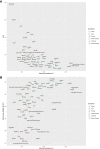Global Burden of Asthma, and Its Impact on Specific Subgroups: Nasal Polyps, Allergic Rhinitis, Severe Asthma, Eosinophilic Asthma
- PMID: 37822519
- PMCID: PMC10563777
- DOI: 10.2147/JAA.S418145
Global Burden of Asthma, and Its Impact on Specific Subgroups: Nasal Polyps, Allergic Rhinitis, Severe Asthma, Eosinophilic Asthma
Abstract
Background: The complex nature of asthma has resulted in a poor understanding of its epidemiology, particularly in low-and middle-income countries (LMIC). Clinical subgroups, such as patients with severe asthma, eosinophilic asthma, allergic rhinitis, or nasal polyps, experience additional barriers to care.
Methods: Prevalence estimates for asthma and key clinical subgroups were extracted from the Global Burden of Diseases, Injuries, and Risk Factors Study 2019 and from a targeted literature review conducted through PubMed in October of 2021. National estimates were calculated and the roles of potential explanatory factors were explored through qualitative analysis.
Results: In total, 162 publications from 69 countries were included. Across continents, asthma prevalence values ranged from 3.44% (Asia), 3.67% (Africa), 4.90% (South America), 5.69% (Europe), 8.29% (North America), to 8.33% (Oceania). Globally, of those with asthma, 26.70% had severe asthma, 30.99% had eosinophilic asthma, 48.95% had allergic rhinitis, and 7.0% to 25.40% had nasal polyps. Countries with higher air quality, income status, and healthcare access and quality reported a higher asthma prevalence.
Conclusion: Asthma prevalence values were low in LMICs, potentially indicating health system deficiencies resulting in low diagnosis and reporting. The prevalence of eosinophilic asthma and severe asthma phenotypes was high in many countries, although the prevalence estimates of all asthma subgroups were quite variable.
Keywords: diagnosis; epidemiology; low- and middle-income countries; prevalence.
© 2023 Rabe et al.
Conflict of interest statement
Professor Adrian Paul J Rabe was an employee of AstraZeneca during the conduct of the study. Dr Wei Jie Loke is an external research consultant who received personal fees from AstraZeneca UK, during the conduct of the study. Miss Khushboo Gurjar and Dr Allison Brackley were employees of Cytel Inc at the time of manuscript writing, which was hired by AstraZeneca to perform study analyses and development of this manuscript. The authors report no other conflicts of interest in this work.
Figures


References
-
- Global Initiative for Asthma – GINA. Global strategy for asthma management and prevention, 2023; 2023. Available from: https://ginasthma.org/wp-content/uploads/2023/07/GINA-2023-Full-report-2.... Accessed September 26, 2023.
LinkOut - more resources
Full Text Sources

